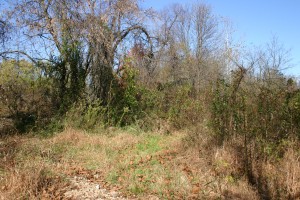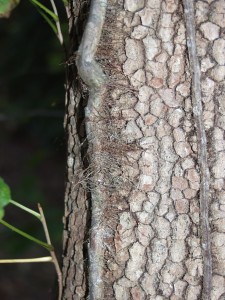As we made our way through the underbrush, the forester observed,
“You have a lot of invasive species, but not as bad as I’ve ever seen. There are mostly three types: Multiflora Rose, Bush Honeysuckle, and Japanese Honeysuckle.”

“Is that bad?”
“If you ignore them, they’ll get worse and take over the forest.” He predicted. “You do have some nice White Oak, Black Walnut and Hickory trees, but you’ve also got some poor quality Locust, Box Elder and Elm trees. These should be thinned out.”
“Are any of the trees ready for harvesting?”
“No”, he responded. “For harvesting, you want a 22 inch diameter tree, measured at chest height. Your largest trees are 14 to 18 inches, and will need a number of more years of growth before they be ready.”
“You also have some Poison Ivy issues.” He said, “There’s two forms…the low, leafy plant on the ground over there (he pointed), and the vine that climbs trees, like over there.” He pointed out a 3-inch thick vine, at least 30 feet tall. “There are tricks you can learn for dealing with Poison Ivy, but for now, just stay away from it.”

“This is a good example of overcrowding.” He spoke, indicating a large tree next to us. “This is a fine Black Walnut tree, but right next to it is another Black Walnut tree, about half its age. The problem is that the little tree competes with the big tree, and in the end, both will suffer. So you need to remove the little trees.”
“Is this all part of the Forest Management Plan?”
“Yes. Most of plan will involve TSI, or Timber Stand Improvement. Clear out the Invasive Plants, Control the Poison Ivy, and thin the trees to favor maximum growth of the healthiest, most valuable trees.”
“I’m feeling a little overwhelmed.”
“You don’t have to do this all yourself. You could do it yourself if you had the knowledge of plants, the right equipment, plenty of time, and the energy to clean up the forest. But I suggest a little different plan for you.”
“OK, what do you think I should do?”
“If I were you, I’d hire someone to come in a do the major TSI for you…clear the brush and thin the trees. Once the heavy work is done, you can come in periodically and touch up the regrowth with your Roundup sprayer and weed whacker. That would be pretty easy to do. If walking the entire forest is going to be too much, get an ATV or Gator to ride around in. I’ve seen a lot of non-resident land owners approach it this way, and they have uniformly enjoyed the time they spent doing this. But let someone else do the heavy lifting.”
“How much do you think this heavy lifting would cost me?”
“Lots of people will charge $100 and acre for the brush clearing and tree thinning. You’ve got a little over 30 acres, so it would cost a little over $3,000. But you don’t have to do it all at once. I’m talking about doing it over 10 years, a little at a time.”
“Is there a particular time of year when it’s best to do this?”
“Fall or Spring, but not during the summer. No one wants to work in the woods in the summer. It’s too hot, it’s too humid, and there are way too many bugs.” (I remembered “Lesson 1” from my Uncle. It sounded very familiar.)
“Remember that once the brush is cleared, it will grow back, so the followup treatment with Roundup or a weed trimmer is really important.”
I left the Forest. The Professional Forester needed to walk the property and inventory the trees. He promised me he’d have the Forest Management Plan finished in a couple of weeks, and that he’d send it directly on to the District Forester for approval.
I needed to start thinking about how I was going to manage this forest.
